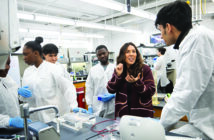Lifesaving skills are needed earlier in medical education.
A few months ago, toward the end of an evening run, I mindlessly ascended the last hill before returning home. Far in the distance I noticed an SUV stopped at an intersection, and as I ran closer, I realized something was horribly wrong. I saw a man lying face down and unconscious with his legs tangled in his bike. He was hyperventilating into a pool of his own blood. Beside him, a woman was screaming. I ran over and told a bystander to call 911. I was luckily joined a few seconds later by a physician who was passing by. Together, we held head stabilization and elevated the patient just enough to allow him to breathe easier. Once the ambulance came, we fitted the patient with a neck collar and flipped him over before he was promptly taken away.
As I finished my run home, I reflected on the irony of the situation I had just left. The skills I used to help this patient I did not learn during the first two years of medical school, but rather from being an emergency medical technician (EMT) in college, a license that expired in 2008. While any second-year medical student can explain the pathophysiology of congestive heart failure or diabetes, very few know what to do when confronted with common emergency situations. Learning these skills earlier in medical school will allow students to help in emergency situations encountered in the real world, something medical students greatly value. It also will provide them with another avenue to engage the clinical side of their future career during an otherwise academically focused preclinical curriculum.
Most medical schools have already incorporated some clinical components into the curriculum during the first two years. At Brown, we are taught CPR during the first week of school and then have a comprehensive course in Doctoring that spans the entirety of medical school. This course teaches students clinical skills such as conducting patient interviews, physical exams, and written and oral presentations. My favorite portion of the course was the afternoon each week I spent with a community physician. During this time I interacted with patients and practiced my newly acquired skills. Still, as a second-year student my contribution to patient outcomes was minuscule.
To give medical students more skills early in their education to treat patients, a small but growing number of schools require students to complete a basic EMT course at the onset of medical school. This certification teaches important lifesaving skills like how to control an airway and the proper technique when moving a patient with a suspected spinal cord injury. At Hofstra, one of the first schools to make EMT training a mandatory component of medical education, a second-year student said while he realized EMT training was only a small portion of the knowledge he would acquire in medical school, it made students “clinically useful from the beginning.” The hope is not only will these students be more engaged in their education, but also be better prepared for clinical rotations in the third year of school.
After my experience with the cyclist, I relayed my story to the administration at Alpert Medical School. I suggested it was important to teach more lifesaving skills at the onset of medical training, even if it is not a complete EMT certification. Teaching basic emergency response skills will increase students’ self-worth as aspiring physicians and may open the doors to more meaningful interactions with patients in the preclinical years. The request was well received, and starting next year incoming students will receive some of this training. I hope this small step will further empower students, helping to remind them why they chose to enter this field.




